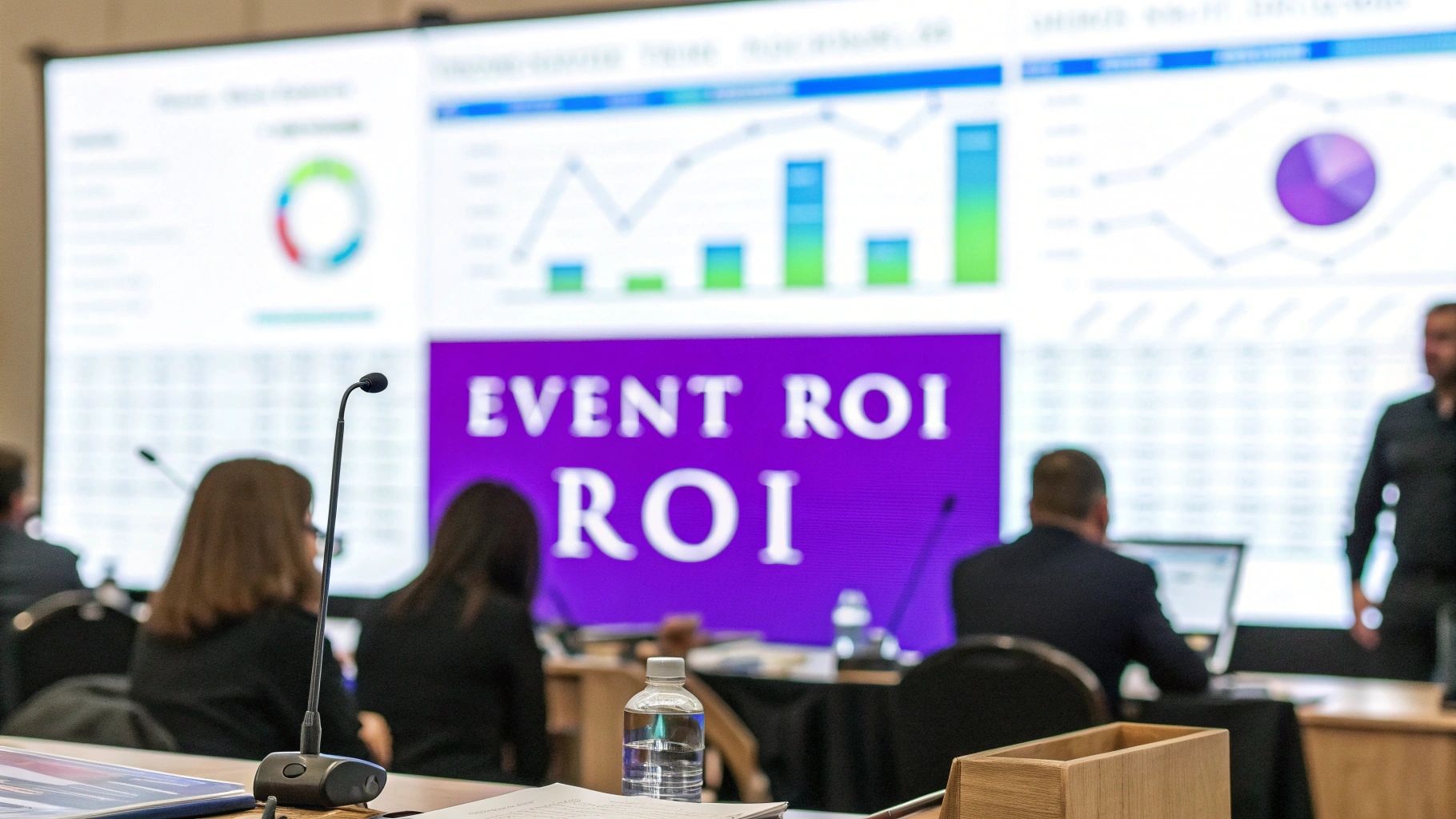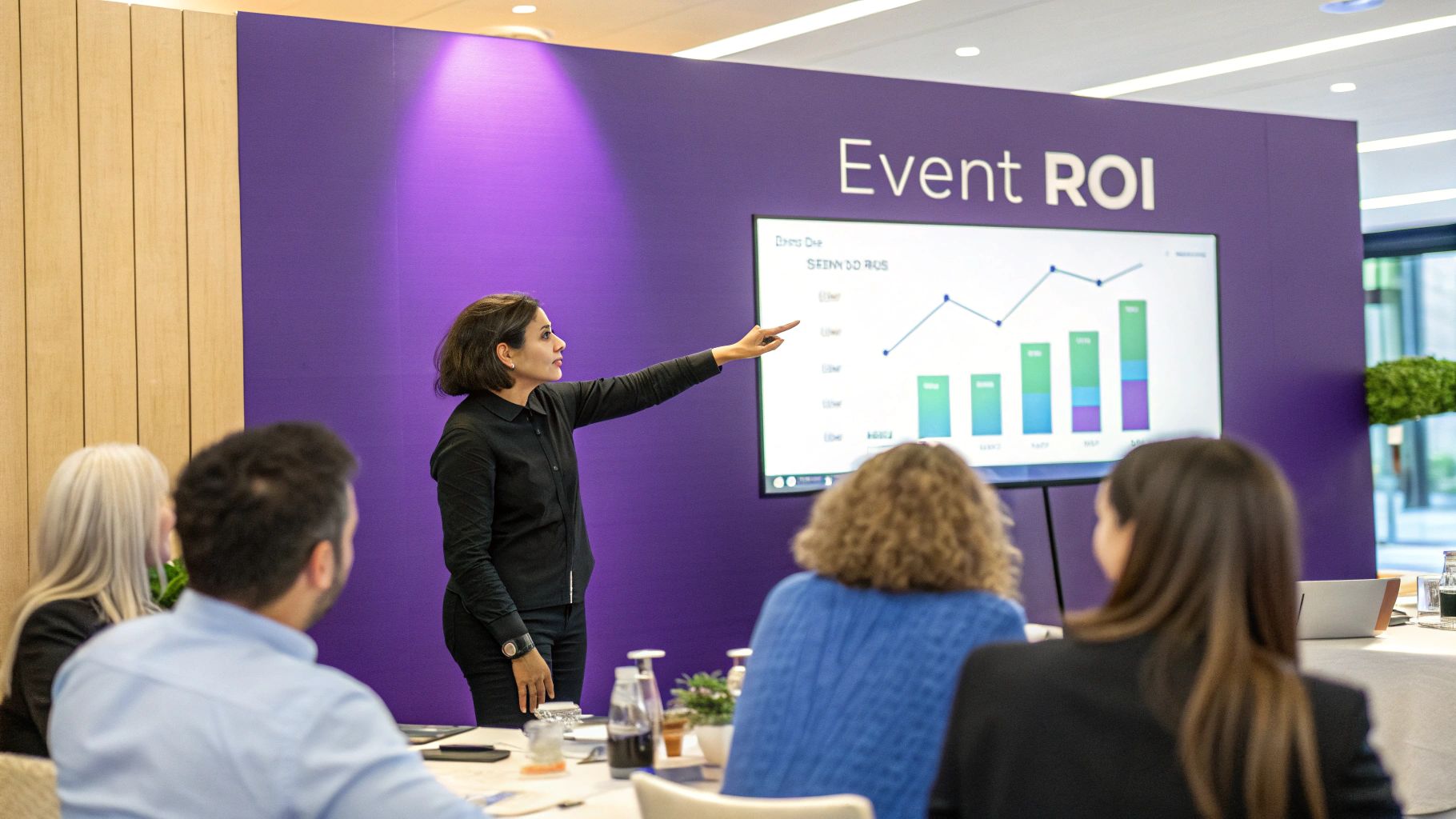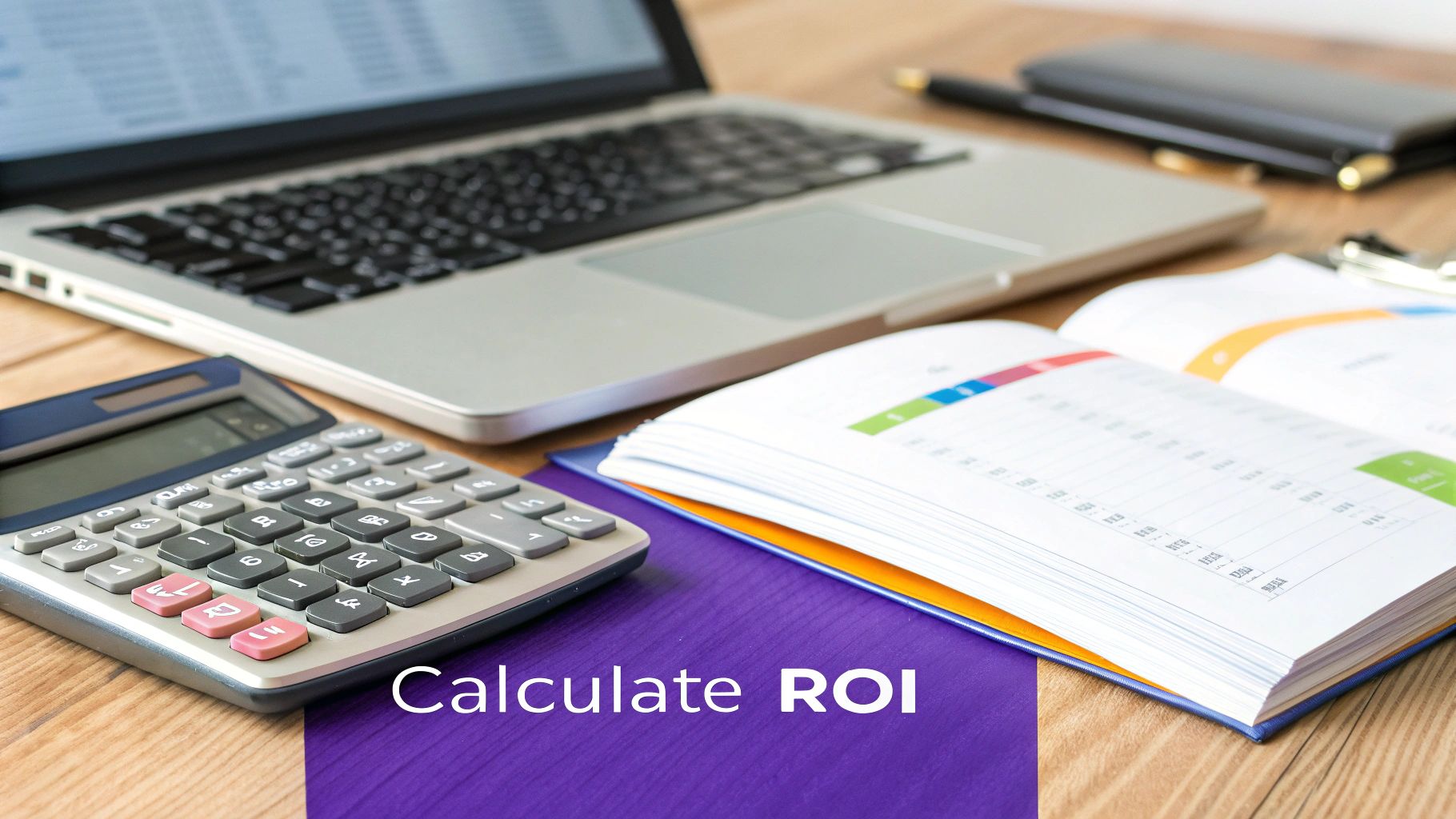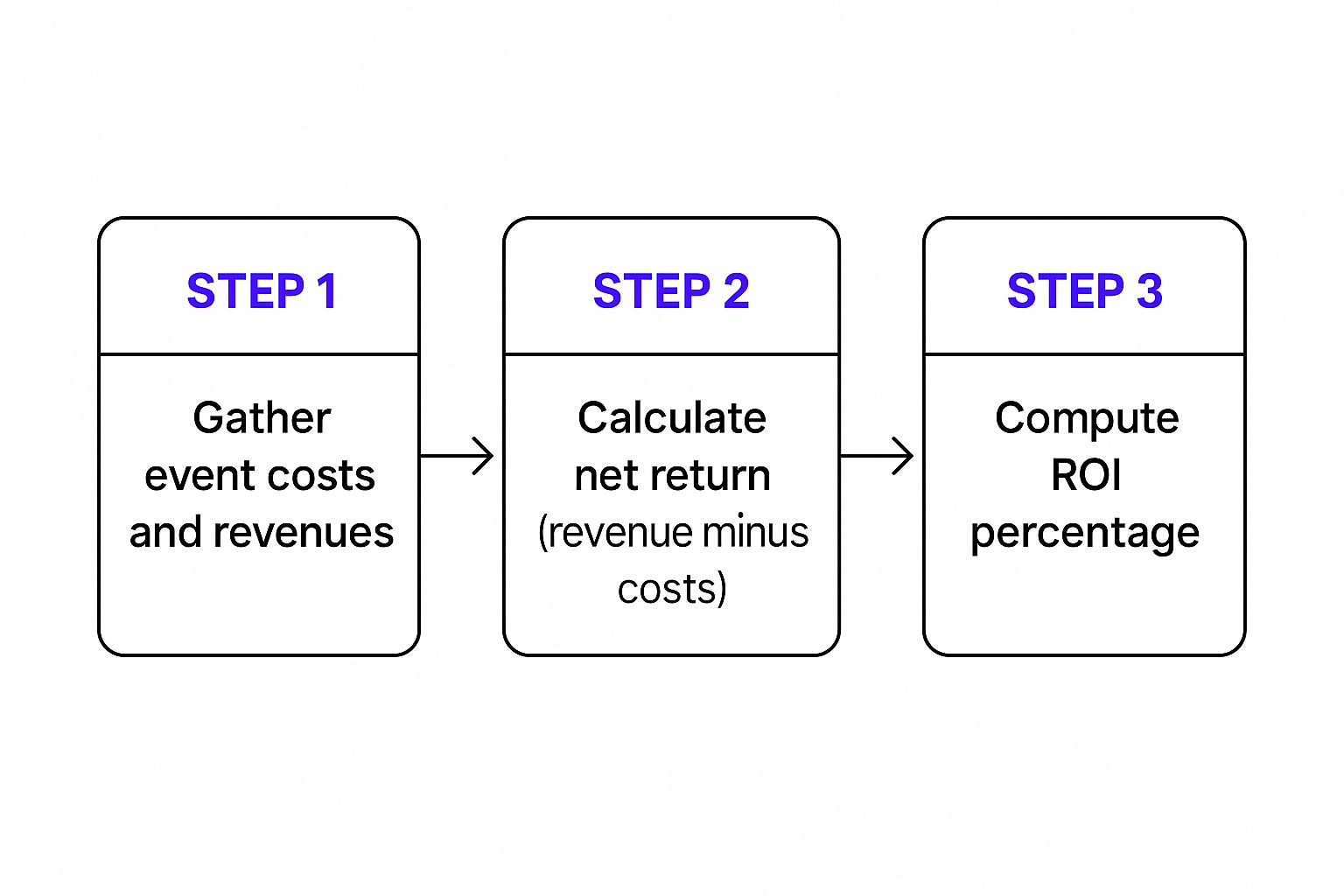A Practical Guide to ROI on Events

Calculating the return on investment (ROI) on events is all about figuring out the real value you got back compared to what you spent. It’s the key metric that takes you beyond simple headcount and shows how your conferences, trade shows, and webinars actually fuel core business goals like revenue and lead generation.
Why Measuring ROI on Events Matters More Than Ever

Let’s be honest, events are a huge financial commitment. Too often, though, their true impact is a total mystery. Without a solid way to measure the outcomes, marketing teams are left scrambling to justify their budgets and prove their worth to the higher-ups. In a world driven by data, "we think it went well" just doesn't cut it anymore.
Stakeholders and the C-suite want to see the numbers. They demand proof that connects event spending to real, tangible business growth. That’s why mastering the ROI on events has gone from a "nice-to-have" skill to an absolute must for any serious marketer today.
The Real Cost of Neglecting ROI
When you don’t track event ROI, you’re dealing with more than just a little uncertainty—you're facing real losses. Flying blind with your event strategy means you're likely repeating expensive mistakes, backing the wrong kinds of events, and missing out on golden opportunities.
This lack of insight almost always leads to:
- Wasted Resources: Pouring money into event formats that just don't deliver.
- Missed Opportunities: Failing to spot which channels and tactics are your top performers so you can double down on them.
- Weakened Credibility: Struggling to defend your marketing budget or show how your team contributes to the bottom line.
The core issue is accountability. When you can't prove the return, every dollar spent on an event is seen as a cost rather than an investment. A solid ROI calculation flips that narrative entirely.
The sheer scale of the events industry highlights how crucial measurement is. The global events market is valued at around $1.4 trillion, and there's good reason for that investment. In fact, between 50% and 61% of marketers report seeing better ROI from their event marketing efforts. You can dig into more of these event marketing statistics in this in-depth industry report.
Shifting from Feelings to Facts
Ultimately, calculating event ROI is about moving from gut feelings to hard facts. It gives you the power to make smart, strategic decisions based on what you know works, not just what you think works.
This shift helps you answer those tough questions from leadership with confidence: Did that big trade show actually generate enough pipeline to justify the cost? Did our webinar bring in high-quality leads that turned into customers?
By providing clear, data-backed answers, you solidify marketing's role as a critical driver of business growth, not just another line item on the expense sheet.
Building Your Foundation for Accurate ROI Tracking

Before you can even think about calculating your event ROI, you have to lay the groundwork. Trying to measure success after the confetti has settled is a recipe for disaster. It's like building a house without a blueprint—messy, unreliable, and almost guaranteed to leave you with a shaky structure.
A solid foundation ensures every dollar spent and every lead generated is properly accounted for, giving you a clear, honest picture of your event's performance. It all starts with getting crystal clear on what you’re trying to achieve.
Define Your Event Objectives
Let's be honest, vague goals like "more brand awareness" are impossible to measure and won't impress your leadership team. You need specific, quantifiable objectives that tie directly back to the company's bottom line.
Are you aiming to generate 150 new marketing qualified leads (MQLs)? Is the primary goal to improve customer retention by 5%? Maybe you want to book 25 sales demos right there on the event floor.
Some common, measurable event objectives include:
- Lead Generation: Setting a hard target for the number of new, qualified leads you need to capture.
- Pipeline Influence: Aiming to create or accelerate a specific dollar amount in the sales pipeline, like $500,000.
- Customer Retention: Focusing on engaging existing customers to reduce churn rates.
- Brand Awareness: Measuring success through concrete metrics like social media mentions, press coverage, or a targeted spike in website traffic during the event.
Your objectives dictate what you measure. If your goal is lead generation, then cost per lead becomes a vital metric. If it's customer retention, you'll focus more on post-event engagement and satisfaction scores.
Once your goals are set in stone, it’s time to track every single cost associated with the event. This is where so many ROI calculations fall apart—by completely overlooking the hidden expenses. To get a handle on the key metrics, check out an expert guide on measuring marketing ROI for growth.
Meticulously Track All Event Costs
To get a true picture of your investment, you have to account for every expense, not just the big-ticket items. Your cost list needs to be exhaustive and broken down into clear categories.
Obvious (Hard) Costs:
- Venue rental and facility fees
- Speaker fees and travel
- Booth design and construction
- Sponsorship packages
- Food and beverage
- Promotional materials and swag
Hidden (Soft) Costs:
- Staff Hours: The salaried time your team spends on planning, travel, and execution. This is a real cost!
- Software Subscriptions: The slice of your event management platform, registration tools, or marketing automation software costs dedicated to this event.
- Post-Event Follow-Up: The resources and time your sales and marketing teams dedicate to nurturing the leads you just generated.
Integrate Your Technology Stack
Finally, accurate ROI measurement hinges on clean, connected data. Your event tech can't operate in a silo. It needs to be integrated to create a seamless journey for every bit of attendee information.
This means connecting your registration platform directly to your CRM, whether it's Salesforce or HubSpot.
This integration is non-negotiable. It’s what allows you to track an attendee from the moment they sign up to the moment they become a paying customer, giving you a crystal-clear line of sight for attribution. To dig deeper, read our guide on how to start leveraging event data to transform attendee insights into strategic advantage.
Without this connected system, leads will inevitably fall through the cracks, and your ROI calculation will be nothing more than a wild guess.
The Essential Formulas for Calculating Event ROI
This is where we get down to brass tacks. The real story of your event's success is told by the numbers, and figuring out your ROI on events isn't as intimidating as it sounds. You don’t need to be a financial wizard, but you do need to get comfortable with a few key formulas that turn your hard work into tangible business results.
At its core, the calculation is refreshingly simple.
Event ROI % = (Net Profit / Total Event Cost) x 100
This little formula gives you a clear percentage showing the return on every dollar you spent. A positive number? You’re in the black. Negative? It was a loss. It's the ultimate litmus test for financial success.
This process flow really simplifies how you can look at the calculation from a high level.

As you can see, the calculation breaks down into three basic parts. It proves you don't need some complex software just to get a solid grasp of your event's financial pulse.
Looking Beyond the Basic Formula
While that standard ROI formula is a fantastic starting point, it doesn't always tell the whole story. To get a truly accurate picture, you have to dig into metrics that align with your specific event marketing goals. Your total return isn't always just about the immediate cash from ticket sales or the deals you closed on the event floor.
This is where metrics like Cost Per Lead (CPL) and Customer Acquisition Cost (CAC) become so important. They help you understand just how efficient your event was as a marketing channel.
- Cost Per Lead (CPL): Simply divide your total event cost by the number of qualified leads you generated. Say you spent $10,000 on a trade show and walked away with 200 solid leads. Your CPL would be a crisp $50.
- Customer Acquisition Cost (CAC): This takes it a step further. If 20 of those 200 leads eventually signed on the dotted line, your event-specific CAC would be $500 ($10,000 / 20 customers).
These calculations are becoming more critical than ever. The event industry is on a massive growth trajectory, projected to leap from $736.8 billion in 2021 to an incredible $2.5 trillion by 2035. With 74% of marketers anticipating budget increases in 2025, being able to prove your event's value is non-negotiable if you want a bigger piece of that pie.
Putting a Price on Non-Revenue Wins
Let's be real—not every event goal is tied to a direct sale. What about the leads that just entered a six-month sales cycle? Or the impact on Customer Lifetime Value (LTV)? To track your event ROI effectively, it’s essential to understand the broader proven strategies and tips for measuring marketing ROI.
To put a value on these outcomes, you'll need to work closely with your sales and finance teams. Sit down with them and figure out the average value for key actions. For example, what's a marketing-qualified lead (MQL) typically worth to the business? If a historical MQL is valued at $150, and your event generated 100 new MQLs, you can confidently assign $15,000 in pipeline value to your event's return.
When you combine direct revenue with the assigned monetary value of these other positive outcomes, you paint a much more complete and accurate picture of your event's total contribution. For more specific guidance on this, you can check out our complete breakdown on calculating https://speakerstacks.com/resources/roi-for-events.
Using Technology To Streamline ROI Measurement
If you're still trying to track event metrics with spreadsheets, you're not just making your life harder—you're working with flawed data and probably missing huge opportunities. In today's world, event technology isn't just a nice-to-have; it's the engine that powers how we measure the ROI on events. These tools work together to create a single, reliable picture of what’s actually happening.
The right tech stack transforms abstract attendee behavior—like a conversation at a booth or a question asked during a Q&A—into solid data points. Instead of guessing who was truly engaged, you can see every touchpoint, from the moment they register to the content they download weeks later. This is how you move from guesswork to accurate attribution.
The Central Role of Event Management and CRM Platforms
At the core of any serious event strategy are two systems: an Event Management System (EMS) and a Customer Relationship Management (CRM) platform. When you connect them, you get a powerful, automated way to track the entire attendee journey.
Think of it like this: platforms like Cvent or Bizzabo manage all the event logistics, while your CRM—something like Salesforce or HubSpot—keeps track of the customer relationship long after the closing remarks.
This integration is what makes calculating real ROI possible. Here’s a simple breakdown of how it works:
- Capture Rich Data: Your EMS is constantly collecting information, from registration details to which sessions an attendee actually sat through.
- Sync Automatically: That data then flows directly into the attendee’s profile in your CRM, no manual entry required.
- Track the Long Game: Now your sales team has the full story. They can see exactly how a lead interacted at the event, which allows you to tie future sales directly back to that initial engagement.
This unified view is what finally closes the attribution gap. It's how you connect the $5,000 you spent on a booth directly to the $50,000 sales opportunity it created six months down the road.
To truly optimize your ROI measurement, it's crucial to select the right tools for the job. Different technologies serve distinct purposes, from capturing initial registrations to analyzing post-event engagement.
Event Technology for ROI Measurement
Here are some of the key technologies and how they contribute to ROI tracking:
- Event Management System (EMS): This is your command center. It manages registration, ticketing, agendas, and attendee communication. For ROI, its key benefit is centralizing pre-event and on-site engagement data, which creates a foundational record of all attendee activity.
- Customer Relationship Management (CRM): This system stores and manages all your customer and lead interaction data. When integrated, it links event engagement data to the entire customer lifecycle, enabling direct attribution of sales back to specific events.
- Event App: A dedicated app provides attendees with schedules, networking opportunities, and interactive features like polls. Its major benefit is capturing real-time engagement metrics like session check-ins and direct messages, which signal high-interest leads.
- Marketing Automation Platform: These tools automate email campaigns, lead scoring, and nurturing workflows. They connect pre- and post-event marketing efforts to attendee behavior, showing the full impact of your entire campaign.
- Business Intelligence (BI) Tools: These powerful platforms aggregate and visualize data from multiple sources. They create comprehensive dashboards that pull data from your CRM and EMS to visualize ROI trends over time, helping you make smarter decisions for future events.
Choosing a well-integrated stack of these technologies ensures that data flows seamlessly from one system to the next. This automation not only saves time but also provides a more accurate and holistic view of your event's financial impact.
The Impact of AI in Event Analytics
Artificial intelligence is taking event analytics to a whole new level. We're moving beyond just collecting data and into the realm of predictive insights. AI algorithms can analyze attendee behavior in real time, scoring leads and flagging the people showing the strongest buying signals. This lets your sales team follow up immediately, while the lead is still hot.
AI can also personalize the event experience on the fly by suggesting relevant sessions or networking connections. This boosts engagement and satisfaction—two key, albeit indirect, drivers of ROI. Some advanced platforms even use predictive analytics to forecast an event's potential success based on past performance.
Technology also helps prove the value of your event content. For example, understanding how attendees engage with session recordings or transcripts is crucial. A great resource on this is the Podcast Transcription ROI Guide, which shows how you can quantify the value of transcribed content. By bringing these technologies together, you build a system that doesn't just measure what happened—it actively helps you get better results next time.
Proven Strategies to Maximize Your Event ROI

Calculating the ROI on events is a great diagnostic tool, but let's be honest—the real goal is to make it better. Simply knowing your numbers isn't the finish line. You have to turn that data into a concrete action plan that makes your next event even more profitable. This is about shifting your mindset from a one-time measurement to a continuous cycle of improvement.
Boosting your return isn't about one magic trick; it requires a smart approach that covers the entire event lifecycle—before, during, and after. By focusing on getting the right people in the door, keeping them hooked, and following up like a pro, you can turn your events from a big expense into a powerful revenue engine.
Attract High-Value Attendees Before the Event
Your event's success is decided long before the first speaker hits the stage. It all comes down to who you invite. Attracting the right audience is everything. After all, about 21% of event professionals point to the struggle of getting the right attendees as a major roadblock to a solid return.
Forget casting a wide, expensive net. Instead, get surgical with your marketing to reach high-value prospects. Zero in on the channels where your ideal customers already hang out.
- Segment Your Email Lists: Stop sending generic blasts. Craft tailored invitations for different customer segments. Highlight the specific speakers or sessions you know will grab their attention.
- Embrace Account-Based Marketing (ABM): For your most important accounts, create hyper-personalized campaigns. Position the event as an exclusive, can't-miss part of their journey with you.
- Tap into Partner Networks: Work with your speakers, sponsors, and industry partners. Ask them to promote the event to their audiences, which extends your reach to fresh, qualified contacts.
Drive Engagement and Personalization During the Event
Once you've got the right people in the room (or on the webinar), your focus has to shift. You need to create an experience that drives real, meaningful engagement. Generic, one-size-fits-all agendas just don't work anymore. Personalization is no longer a "nice to have"—it's a must.
In fact, a staggering 96% of marketers agree that creating tailored experiences at events directly improves sales outcomes.
The goal is to make every single attendee feel like the event was designed just for them. This level of personalization doesn't just make people happy; it generates a ton of rich data you can use to spot your hottest leads in real time.
Your event app is your secret weapon here. Use it to track which sessions people attend, which sponsor booths they visit, and what content they download. This data is pure gold for your sales team. It tells them exactly who to follow up with first—the prospects who are already highly engaged and interested.
Convert Leads with Rapid Post-Event Nurturing
The work isn't done when the last session wraps up. In fact, the post-event phase is where most of the ROI is either locked in or lost forever. You need a fast, structured follow-up plan to capitalize on the momentum you've built.
Don't wait weeks to get in touch. Your lead nurturing sequence should kick off within 24-48 hours.
- Immediate Thank You & Resources: Send a personalized thank-you email right away. Make sure it includes links to session recordings, presentation slides, or any other resources you promised.
- Segmented Sales Follow-Up: Arm your sales team with all that juicy engagement data you collected. Their outreach should be tailored to each attendee's specific interests and activity level.
- Create a Feedback Loop: Post-event surveys are great for measuring satisfaction, but they can do so much more. Ask targeted questions that help you qualify leads further and give you priceless feedback for your next event.
Following these strategies will give your return a serious boost. For a deeper dive into this topic, you can also explore our guide on how to https://speakerstacks.com/resources/measure-event-roi.
Even with the best tools in your arsenal, trying to pin down the ROI on an event can feel like trying to nail Jell-O to a wall. It’s a common struggle, so let’s walk through some of the biggest questions and sticking points that trip up even seasoned event marketers.
How Do I Measure ROI for a Brand Awareness Event?
This is the million-dollar question, isn't it? When your event is all about getting your name out there, not closing deals on the spot, you have to think differently. Forget direct revenue for a moment and focus on the value of visibility. It's like putting up a billboard—you know it's working, but you can't tie every sale back to it directly.
So, how do you put a number on brand presence? You track metrics that show your brand's growing footprint.
- Social Media Buzz: Keep a close eye on your event hashtag. How many people are using it? What’s the total reach? Also, look for a bump in your follower count across platforms during and right after the event.
- Earned Media: Did you get any press coverage? Tally it up and calculate its equivalent media value. In other words, what would you have paid in advertising to get that same level of exposure?
- Website Traffic: Check your analytics for a noticeable spike in direct and organic traffic to your website. This is a clear sign that people who heard about you at the event are now actively seeking you out.
You can then assign a dollar value to these wins by looking at what it would cost to achieve the same results through paid advertising. This gives you a much more tangible figure to work with.
What’s a Good Benchmark for Event ROI?
Everyone wants that magic number, but the honest answer is: it depends. A "good" ROI is completely relative to your industry, your specific goals, and how established your event program is.
That said, if you're looking for a general target, many marketers aim for a 3:1 to 5:1 ratio. This means for every dollar you spend, you're generating three to five dollars in value—a 300% to 500% return.
But remember, the most important benchmark is your own previous performance. For a first-time event, just breaking even while collecting a mountain of data and feedback is a huge win. The real goal is to get a little better each time you run an event.
How Long After an Event Should I Calculate ROI?
This one is all about your sales cycle. Pulling the plug on your ROI calculation too soon is a surefire way to get a disappointing—and inaccurate—number.
If you have a short sales cycle, maybe just a few days or weeks, you can probably get a solid read on your ROI within 30-60 days.
But for B2B companies with sales cycles that can drag on for months, sometimes even a year, calculating ROI becomes a long-term project. You'll want to do it in stages. Run an initial calculation after 30 days to measure immediate impact, like Marketing Qualified Leads (MQLs). Then, circle back at the six-month and twelve-month marks to see how many of those leads actually became paying customers.
What Are the Most Common Mistakes in ROI Calculation?
Most errors boil down to two things: fuzzy planning and sloppy tracking. One of the classic blunders is forgetting to account for all the costs. People are great at tracking vendor invoices but often forget the "soft" costs, like the salaried time their own team pours into planning and running the show.
Another huge pitfall is starting with vague objectives. If you never clearly define what success looks like from the beginning, you'll have no idea how to measure it later. And finally, a lot of marketers simply give up too early, focusing only on the immediate revenue and completely ignoring the long-term gold found in customer retention and new partnership opportunities.
Ready to turn your speaking engagements into a powerful lead-generation engine? With SpeakerStacks, you can create a branded landing page with a unique QR code in seconds, capturing attendee interest in real time. Stop letting leads walk out the door and start measuring your true event ROI. See how it works at https://speakerstacks.com.